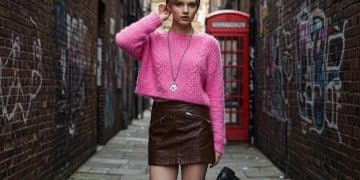Secure Funding for Your Fashion Design Startup: US Guide

Securing funding for a fashion design startup in the US involves understanding various financing options, crafting a solid business plan, and networking effectively to attract investors.
Starting a fashion design startup can be incredibly rewarding, but also financially challenging. This guide will walk you through the essential steps on how to secure funding for your fashion design startup: a guide for US entrepreneurs, ensuring you have the resources to bring your creative vision to life.
Understand Your Funding Needs
Before diving into funding options, it’s crucial to accurately assess your financial requirements. This understanding will guide your approach and help you target the right funding sources.
Detailed Cost Breakdown
Compile a comprehensive list of all anticipated expenses. This includes startup costs like equipment, studio space, initial inventory, and marketing expenses, as well as ongoing operational costs such as salaries, rent, utilities, and raw materials.
Realistic Budgeting
Develop a realistic budget that accounts for potential overspending and unexpected costs. Include contingency funds to cover unforeseen circumstances. Also, project your revenue streams and sales forecasts to determine how much external funding you’ll truly need.
To help visualize your financial needs, consider using financial modeling tools or consulting with a financial advisor. These resources can provide valuable insights and ensure your budget is well-structured and accurate.

Here are key areas to focus on when determining your funding needs:
- Prototype Development: Costs associated with creating samples and refining your designs.
- Manufacturing: Expenses related to producing your fashion line at scale.
- Marketing & Branding: Investments in building your brand and reaching your target audience.
- Operational Costs: Day-to-day expenses like rent, utilities, and salaries.
By carefully analyzing these areas, you’ll be better prepared to seek the necessary funding to launch and sustain your fashion design startup. Remember, thorough planning is the foundation for financial success.
Explore Funding Options
Once you have a clear understanding of your financial needs, it’s time to explore the various funding options available to fashion design startups in the US. Each option has its own advantages and disadvantages, so it’s important to choose the right fit for your business.
Bootstrapping
Bootstrapping refers to self-funding your startup using personal savings, credit cards, and revenue generated from initial sales. This option allows you to maintain full control of your business and avoid debt or equity dilution.
Loans and Credit Lines
Small business loans and credit lines from banks and credit unions can provide the capital you need to cover startup costs or finance inventory. Look into options like SBA loans, which often offer favorable terms for small businesses.
Angel Investors and Venture Capital
Angel investors are individuals who invest their personal funds in early-stage companies. Venture capitalists are firms that invest in high-growth potential startups in exchange for equity. These options can provide significant funding but often require giving up a portion of ownership.

Consider these additional funding avenues:
- Crowdfunding: Platforms like Kickstarter and Indiegogo allow you to raise funds from a large number of people in exchange for rewards or early access to your products.
- Grants: Government agencies and private foundations offer grants to support small businesses, particularly those in creative industries.
- Friends and Family: Seeking financial support from your personal network can be a viable option, but make sure to formalize the arrangement with a written agreement.
Carefully evaluate each funding option based on your specific needs and circumstances. Determine which source aligns best with your long-term goals and financial capabilities. Understanding the pros and cons of each will help you make an informed decision.
Craft a Compelling Business Plan
A well-crafted business plan is essential for attracting investors and securing funding. It serves as a roadmap for your business and demonstrates your understanding of the market and your ability to execute your vision.
Executive Summary
Begin with a concise and persuasive executive summary that highlights your business concept, target market, competitive advantage, and funding request. This section should capture the attention of potential investors from the outset.
Market Analysis
Provide a detailed analysis of the fashion industry, including market trends, target audience demographics, and competitive landscape. Demonstrate your understanding of your customers’ needs and how your products meet those needs.
Your business plan should also include a detailed financial forecast and operational plan.
Financial Projections
Include realistic revenue projections, expense budgets, and cash flow statements. Show potential investors how you plan to generate revenue, manage costs, and achieve profitability. A solid financial forecast builds trust and confidence.
Operational Plan
Outline your manufacturing process, supply chain management, and distribution strategy. Explain how you plan to efficiently produce and deliver your products to customers. Operational efficiency is key to long-term success.
Here are vital components to include in your business plan:
- Company Description: A summary of your business, its mission, and its goals.
- Products and Services: Detailed descriptions of your fashion designs and unique selling points.
- Marketing Strategy: How you plan to reach and engage your target audience.
- Management Team: Profiles of key personnel and their relevant experience.
A compelling business plan not only attracts investors but also guides your business’s growth and development. It serves as your company’s blueprint for success.
Network and Build Relationships
Building a strong network is crucial for accessing funding opportunities and industry insights. Networking can open doors to potential investors, mentors, and collaborators who can support your startup’s growth.
Industry Events
Attend fashion industry events, trade shows, and conferences to meet potential investors and industry experts. These events provide a valuable platform to showcase your designs and build relationships.
Online Communities
Engage with online communities, forums, and social media groups dedicated to fashion and entrepreneurship. These platforms provide opportunities to connect with like-minded individuals and share your ideas.
Building relationships with mentors and industry professionals can offer invaluable advice and support.
Mentorship
Seek out mentors who have experience in the fashion industry or startup funding. Their guidance can help you navigate challenges and make informed decisions. Mentorship provides a wealth of knowledge and perspective.
Professional Advisors
Consult with professional advisors, such as accountants, lawyers, and business consultants, to ensure your business is set up for success. Their expertise can help you avoid costly mistakes and optimize your financial strategies.
Focus on these networking strategies:
- Join Industry Associations: Connect with professionals in your field through industry-specific organizations.
- Attend Workshops and Seminars: Enhance your knowledge and expand your network by participating in educational events.
- Utilize LinkedIn: Build your professional network and connect with potential investors and collaborators.
Networking and relationship building are vital for securing funding and navigating the complexities of the fashion industry. Strong connections lead to valuable opportunities and support.
Prepare a Pitch Deck
A pitch deck is a concise presentation that summarizes your business plan and highlights key aspects to potential investors. It should be visually appealing, informative, and persuasive.
Key Slides
Include slides that cover your business concept, market opportunity, target audience, competitive advantage, financial projections, and funding request. Each slide should convey essential information clearly and concisely.
Visual Appeal
Use high-quality images, graphics, and charts to make your pitch deck visually engaging. A well-designed pitch deck captures attention and reinforces your message. Visuals should complement and enhance your content.
Practice your presentation to deliver a confident and persuasive pitch.
Practice Delivery
Rehearse your pitch multiple times to ensure you can deliver it smoothly and confidently. Be prepared to answer questions from potential investors and address any concerns they may have. Confidence is key to convincing investors.
Tailor to Audience
Customize your pitch deck to suit the specific interests and expectations of your audience. Research potential investors and tailor your presentation to highlight the aspects of your business that are most relevant to them. Customization demonstrates your understanding of their needs.
Incorporate these elements into your pitch deck:
- Problem Statement: Clearly articulate the problem your fashion design startup is solving.
- Solution: Explain how your products or services address the identified problem.
- Team: Showcase the expertise and experience of your management team.
A well-prepared pitch deck is a powerful tool for attracting investors and securing funding. It effectively communicates your vision and convinces potential backers of your startup’s potential.
Consider Crowdfunding
Crowdfunding platforms offer an innovative way to raise capital by appealing to a broad audience. They can also help you build a community around your brand and generate early sales.
Platform Selection
Choose a crowdfunding platform that aligns with your target audience and industry. Kickstarter and Indiegogo are popular options for creative projects and fashion startups. Assess each platform’s fees, features, and audience demographics.
Campaign Planning
Develop a comprehensive campaign plan that includes a compelling story, attractive rewards, and a clear funding goal. Set realistic milestones and create a timeline for your campaign. Planning is essential for success.
Engage with your backers and provide regular updates throughout the campaign.
Engagement
Communicate with your backers regularly and provide updates on your progress. Respond to questions and comments promptly and keep your community engaged. Engagement fosters loyalty and enthusiasm.
Marketing and Promotion
Promote your crowdfunding campaign through social media, email marketing, and public relations. Reach out to influencers and media outlets to generate buzz and attract more backers. Effective marketing is crucial for reaching your funding goal.
Here are best practices for a successful crowdfunding campaign:
- High-Quality Visuals: Use professional photos and videos to showcase your designs.
- Compelling Story: Share your passion and vision to connect with potential backers.
- Attractive Rewards: Offer a variety of rewards that appeal to different levels of support.
Crowdfunding can be an effective way to raise capital, build brand awareness, and connect with your target audience. A well-executed campaign can provide the funding and support you need to launch your fashion design startup.
| Key Element | Brief Description |
|---|---|
| 💰 Funding Needs | Assess all costs, including startup & operational, for accurate budgeting. |
| 📊 Business Plan | Create a plan with market analysis & financial projections. |
| 🤝 Networking | Build connections to find investors, mentors, & collaborations easily. |
| 🚀 Pitch Deck | Craft a concise summary with engaging visuals on your business concept. |
FAQ Section
▼
Start by assessing your funding needs, building a comprehensive business plan, and exploring various funding options like loans, investors, and crowdfunding. Understand your financial landscape thoroughly.
▼
A sturdy business plan is essential as it acts as a roadmap for investors. It highlights your market understanding, financial projections, and overall business strategy, increasing investor confidence.
▼
Crowdfunding allows you to raise capital from a broad audience, build a brand community, and generate early sales. It’s an opportunity to market your vision and gain quick funding.
▼
Networking opens doors to potential investors, mentors, and industry insights. Building strong connections can offer invaluable advice, support, and funding opportunities for your startup’s growth
▼
A pitch deck should include your business concept, market opportunity, target audience, competitive advantage, financial projections, and funding request. Use high-quality visuals to engage investors.
Conclusion
Securing funding for your fashion design startup requires a strategic approach, combining thorough financial planning, compelling storytelling, and effective networking. By understanding your funding needs, exploring various options, and building strong relationships, you can increase your chances of securing the capital needed to bring your creative vision to life and thrive in the competitive fashion industry.





